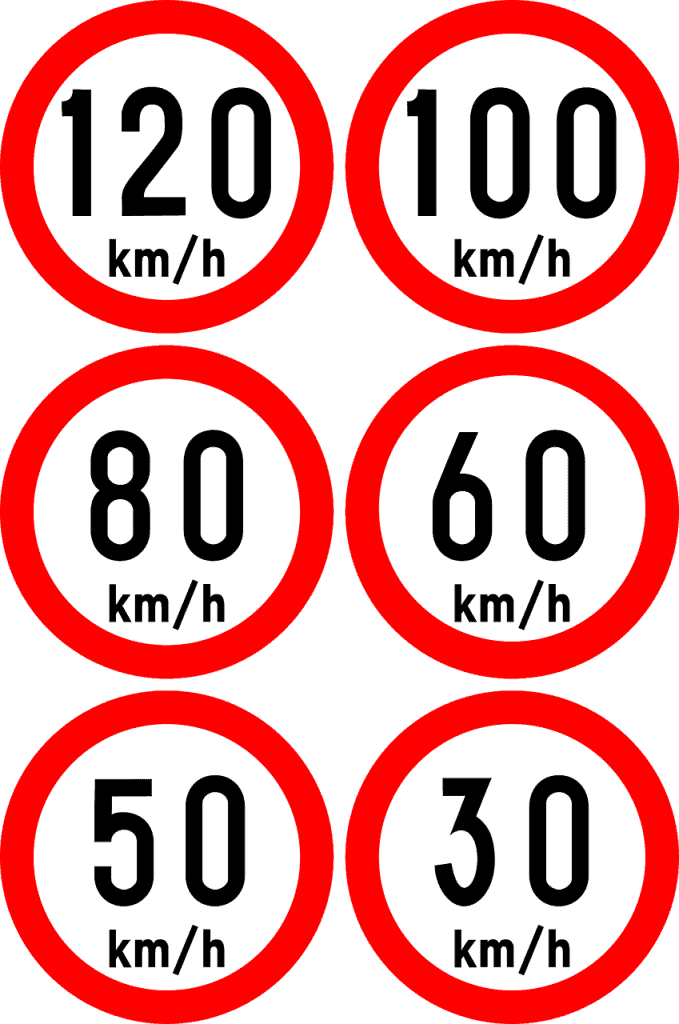Embarking on an unforgettable road trip through the enchanting Irish Landscapes To make your journey through the emerald Isle as smooth and enjoyable as possible, it’s essential to familiarise yourself with the ins and outs of driving in Ireland. From navigating narrow country roads to embracing local etiquette, this comprehensive guide will prepare you for a safe and memorable Irish driving experience.
Key Takeaways
Navigate the roads of Ireland with ease by selecting an appropriate vehicle, understanding rental agreements and mastering left-hand driving dynamics.
Adhere to local customs such as roundabout etiquette, speed limits and signage while meeting legal requirements.
Use GPS devices, traditional maps for route planning, and smartphone navigation apps for (fairly) accurate directions.
Navigating Irish Byways: A Rental Car Guide
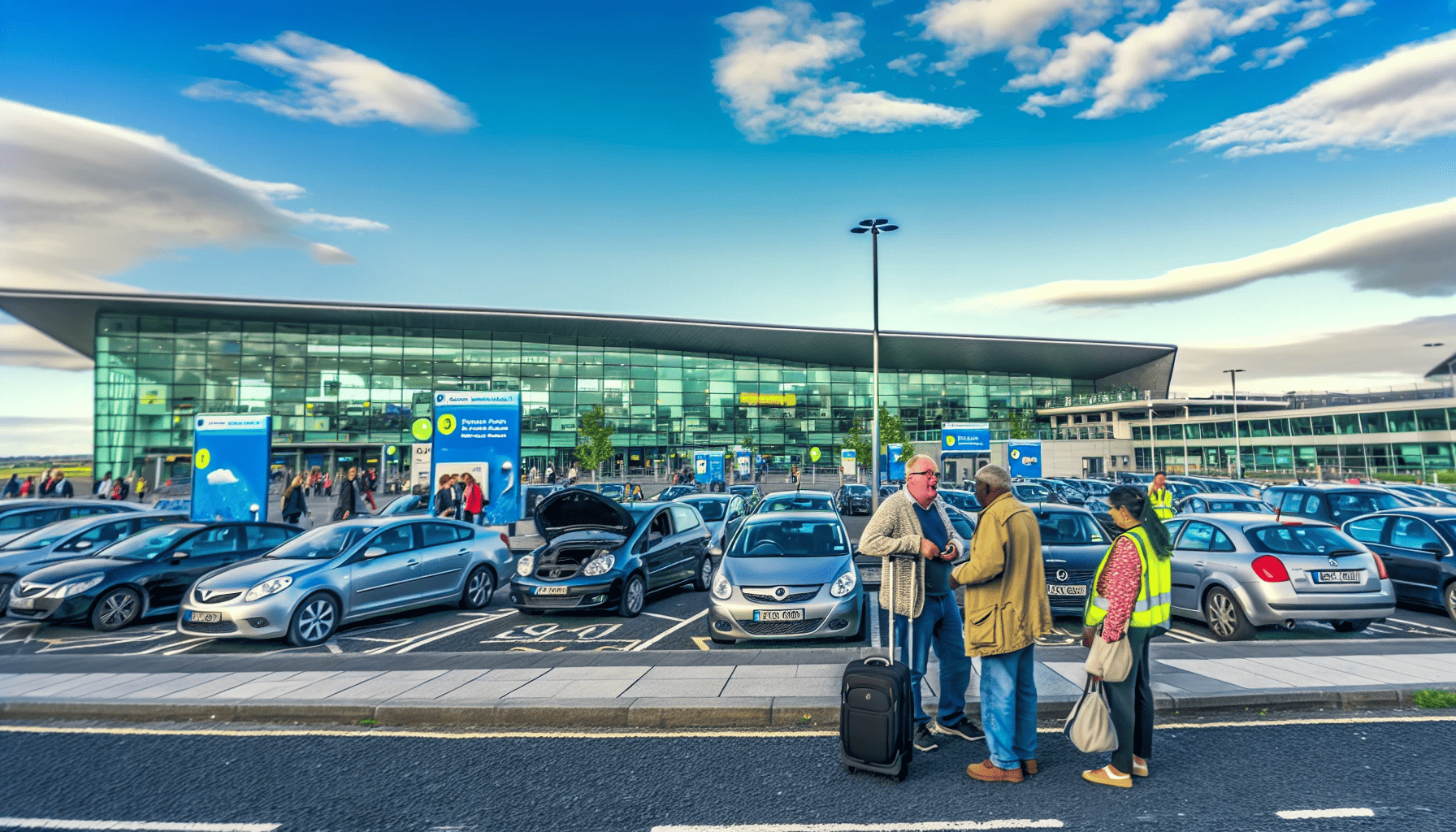
A rental car is one of the most common routes (excuse the pun) to an unforgettable Ireland road trip. To kickstart your adventure, consider the type of vehicle you’ll need (you probably don’t need an SUV…. or a convertible), understand the rental agreement (ie the insurance and fees – companies are bad for that here), and plan for a seamless car pick-up experience at Dublin Airport. In addition, it’s also good to familiarise yourself with the road rules, understand different road signs, and master some of the unique Irish driving situations, such as roundabouts. Since Ireland drives on the left side of the road, we recommend renting a car with an automatic transmission, although most options are manual as that’s what most Irish drive, to focus solely on driving instead of shifting gears….. no one wants to start their road trip bouncing their car out of the airport.
When driving into the larger Irish cities and towns, it’s advisable to either utilise public transport and park outside the city centre or find a car park (parking lot) close to where you want to go – I recommend using the Parking Tag App as its the easiest way to find and pay for parking in Ireland. City streets are often narrow, requiring your attention, and parking may be challenging at times. With these factors in mind, let’s explore some tips for selecting the perfect rental car for your Irish journey, considering the option of rental companies in Ireland.
Choosing the Right Vehicle for Your Road Trip
Choosing the right vehicle to explore Ireland’s scenic landscapes is key to a comfortable and trouble-free journey. Here are some tips to consider:
Opt for a smaller car (medium size cars generally offers a compromise between comfort and economy) when renting, as the narrow country roads and tight parking spaces make manoeuvrability a priority.
If you’re experienced with driving a “stick shift,” renting a manual car can be a viable option. It offers increased fuel efficiency and an enhanced driving experience.
However, if you’re unfamiliar with a stick shift or prefer not to challenge yourself, an automatic car will make your journey much more manageable.
Remember, a trip to Ireland means adjusting to driving on the left-hand side, so pick a vehicle that matches your driving experience.
Understanding Rental Agreements
Before you start your journey, make sure you understand the rental agreements for your car from most car rental companies. Rental agreements typically include insurance coverage (check your coverage & excesses), mileage limits, and additional fees. Be aware that travel between Ireland and Northern Ireland should be considered during the reservation process. To cut costs, we recomend you book your rental car in advance, particularly during the peak seasons between May and September.
In Ireland, Collision Damage Waiver (CDW) insurance is mandatory and reduces your liability for damage to the vehicle to approximately €2500. For added peace of mind, it’s highly recommended to purchase Super CDW insurance, which further reduces your liability to a maximum of €100. If your credit card covers CDW insurance, be prepared to submit proper documentation for any claims, such as:
pictures
police reports
estimates
final bills
Picking Up Your Car at Dublin Airport
Dublin Airport is a great location to pick up your rental car, as it allows you to avoid driving in the city center. Ensure you’re aware of the operating hours of your chosen car rental agency, as these may vary.
When you pick up your car, take a wander round the car to familiarise yourself with it. Don’t forget to ask at the airport to have the necessary currency for tolls covered or if you have to cover them. You can find out more here at the eflow website – https://www.eflow.ie/tourist-rental-information/
Mastering Left-Hand Driving Dynamics
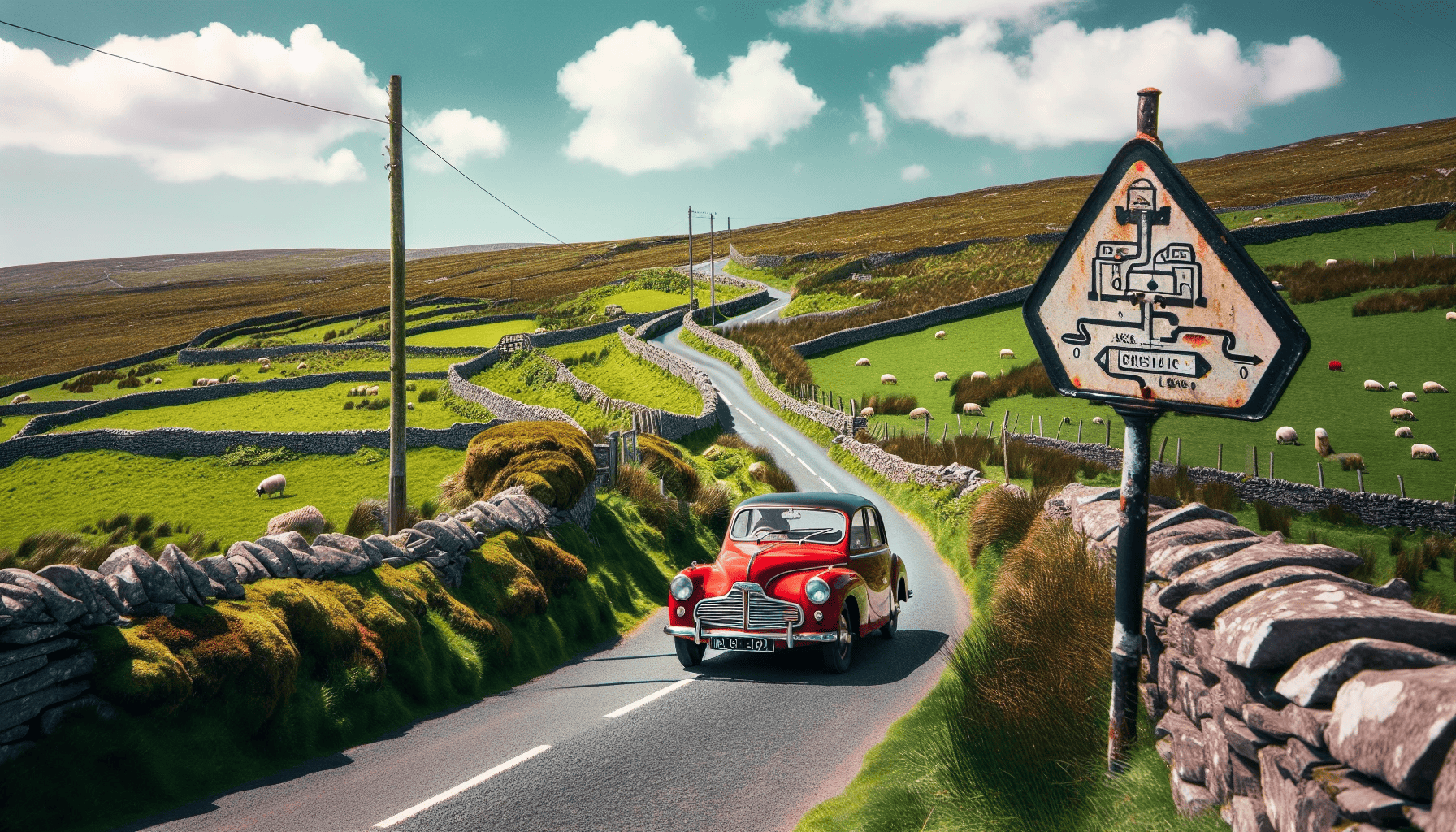
Adapting to drive on the left side of the road in Ireland can initially seem overwhelming, but with practice and patience, you’ll quickly get used to it. It’s essential to look in your side and rear mirrors frequently, as they’re your only way to accurately gauge your space on the road. On smaller country roads, the left line is particularly important, as it informs you of the available space should larger vehicles, like trucks or tour buses, approach on the narrow lane.
Let’s look deeper into left-hand driving in Ireland, including the choice between stick shift and automatic vehicles and the etiquette of navigating the roads and roundabouts of ireland.
The Shift in Perspective: Stick Shift vs. Automatic
Choosing between a manual or an automatic car for your Irish trip depends on your personal preference and driving skills. Stick shift cars, or manual transmission vehicles, offer increased fuel efficiency and a potentially enhanced driving experience on the winding roads but require more skill to operate and can be more challenging when adapting to driving on the left side of the road.
On the other hand, automatic cars are easier to drive and require less skill, although they may be less fuel-efficient and more expensive to rent as the majority of Irish, and European, cars are manual. For those new to driving on the left side of the road, an automatic car is highly recommended to ensure a smoother and more enjoyable journey.
Roundabout Etiquette
Navigating roundabouts in Ireland necessitates following particular rules and practices. Here are some guidelines to keep in mind:
Traffic circulates clockwise on the ring road.
Drivers must yield to vehicles already on the roundabout coming from the right.
When approaching a roundabout, use the right-hand lane unless road markings indicate otherwise.
Always maintain a safe distance from the vehicle in front.
Use your indicators to signal your direction (where you want to go) intentions.
Prioritise safety by adhering to the flow of traffic.
Mastering roundabout etiquette will ensure you confidently navigate these unique traffic features and blend in seamlessly with local drivers…..and avoid getting honked at.
Comprehending Irish Speed Limits and Road Signs
Getting to know Irish speed limits and road signs is key to ensuring a safe driving experience. Here are some important things to remember:
Speed limits in Ireland are 50 km/h in urban areas, 80 km/h on regional roads, and 120 km/h on highways or motorways.
Be aware that certain road signs may differ from what you’re accustomed to, and many will be written in Irish (or Irish Gaelic).
To avoid fines or accidents, always adhere to the speed limit.
Let’s examine how to decipher speed limit signs and interpret unique Irish signage for a smooth driving experience.
Deciphering Speed Limit Signs
Knowing the different speed limit signs in Ireland is important for safe and lawful driving. Speed limit signs in Ireland resemble those in the United Kingdom, featuring a white circle with a black band displaying the speed limit. There are five distinct speed limits in operation in both the Republic of Ireland and Northern Ireland, based on the type of road and location.
Familiarising yourself with these signs will help you abide by the legal limits and ensure a safe journey for both you and other road users.
Interpretation of Unique Irish Signage
Identifying and understanding distinctive Irish road signs is key to effortless navigation. In Ireland, you’ll encounter a variety of signs, including:
Warning signs for dangerous bends
Green signs with white letters for national road directions
Blue signs with white letters for motorways
Signs showcasing the Transport and Motorway typefaces
By familiarizing yourself with these unique signs, you’ll be better prepared to navigate Ireland’s roads with confidence and ease.
Essential Legalities: Licenses and Insurance
Having the correct licenses and insurance is a significant component of driving in Ireland. Drivers must possess a valid driver’s license from the US, Canada, or the EU, as well as third-party insurance. Tourists from other countries may require an International Driver’s Permit.
Let’s explore the legality of foreign driver’s licenses and insurance requirements for a seamless Irish driving experience.
Legality of Foreign Driver’s Licenses
Confirming if your overseas driver’s license is valid for driving in Ireland is important for a smooth journey. Here are some key points to keep in mind:
Tourists from the US, Canada, and the EU with a valid driver’s license are permitted to drive in Ireland for up to 12 months.
Other countries may necessitate an international driving permit (IDP), especially if the driver’s license is not in English.
Be aware that there may be penalties for driving with a foreign license, such as receiving penalty points and fines for driving unaccompanied.
It’s advised to exchange your foreign license for an Irish driving license within 10 years of its expiration.
Navigating Insurance Policies
Knowing the different types of insurance coverage available for car rentals in Ireland is crucial for a worry-free journey. Third-party insurance is mandatory, and Collision Damage Waiver (CDW) insurance is required to rent a car in Ireland. CDW insurance helps limit your financial responsibility for any damage to the rental vehicle. This liability is usually reduced to approximately € 2500.
For added assurance, consider purchasing Super CDW insurance, which further reduces your liability to a maximum of €100. Ensure you’re well-informed about insurance policies and coverage to protect yourself and your rental car.
Parking and Tolls: What You Need to Know
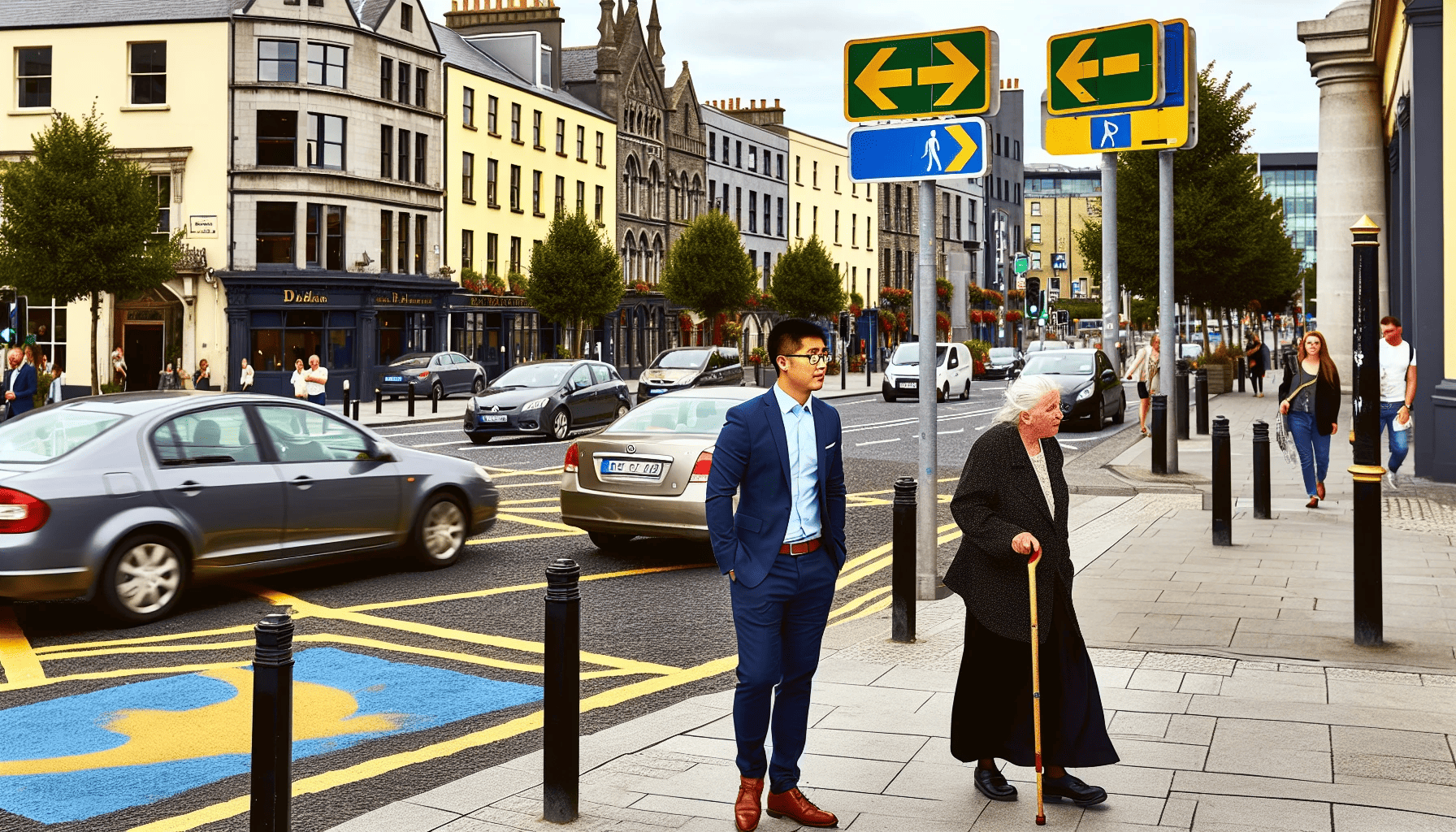
Handling parking and tolls is a significant part of driving in Ireland. There are 11 toll roads in Ireland, including major motorways and national roads, as well as bridges. You can avoid toll roads by setting your GPS navigation to bypass them. Simply select the option on the GPS menu when inputting your destination.
Parking in bustling Irish cities can be challenging, so it’s important to know where to find parking and how to manage fees. Let’s delve into tips for finding parking in busy cities and managing toll roads and fees.
Finding Parking in Bustling Irish Cities
When it comes to finding parking in busy Irish cities, it’s important to:
Locate designated parking garages
Be prepared for potentially high costs
Note that parking in town centers, such as Cobh or Kinsale, is strictly regulated
Generally, parking is free outside the indicated hours
To save on parking costs, consider staying in a hotel with private parking when visiting the city overnight. By being aware of parking regulations and fees, you’ll be better prepared to navigate urban parking in Ireland.
Managing Toll Roads and Fees
Managing toll roads and fees in Ireland requires understanding of payment methods and locations. Here are some important things to know:
Most toll roads accept card payments and coins.
The M50 toll must be paid before 8 PM the following evening.
Failing to pay tolls on time can result in fines and penalty fees from the rental car company for processing the matter.
Keep a sufficient amount of change on hand for toll payments, and consider using navigation apps to avoid toll roads, saving you both time and money.
Fueling Your Journey: Gas Stations and Budgeting
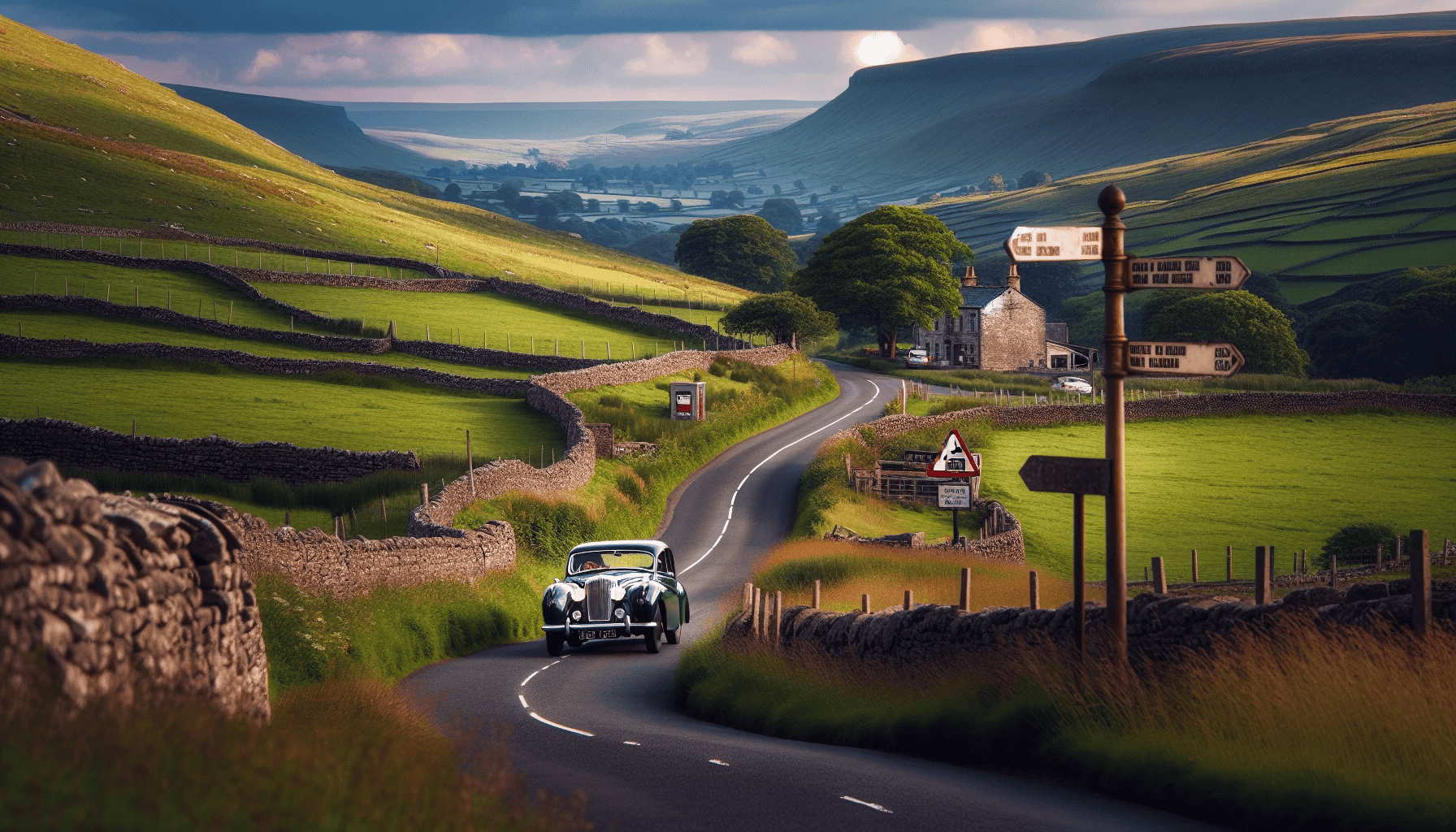
Making sure you have sufficient fuel is crucial for a seamless and pleasurable road trip. Gas stations are abundant in Ireland, particularly along national and regional roads, and can be found in most towns and villages.
To save on fuel costs, consider renting a diesel car, which is typically more fuel-efficient and less expensive per liter than gasoline. Let’s explore tips for locating gas stations and budgeting for fuel costs in Ireland.
Locating Petrol Stations
Finding petrol stations in Ireland is relatively easy, with popular chains like:
Circle K
Maxol
Top Oil
Applegreen
operating throughout the country. Along highways, there’s an approximate frequency of 6.8 petrol stations per 100 kilometers. Most gas stations in Ireland are self-service, so be prepared to fill up your tank and pay at the counter.
For added convenience, consider using apps like Pumps.ie and Fuel Up Finder to locate petrol stations, particularly in rural areas.
Budget Tips for Fuel Costs
To budget for fuel costs during your Irish road trip, consider the following:
The price of petrol is roughly €1.42 per liter.
Employ fuel-efficient driving practices, such as gently accelerating, coasting to decelerate, and maintaining a steady speed.
Regularly fill up your tank in rural areas to avoid running out of fuel in isolated locations.
By taking these factors into account and monitoring your fuel consumption, you’ll be better equipped to budget for fuel expenses during your journey.
Adapting to Irish Weather and Road Conditions
Ireland’s moderate climate generally provides enjoyable driving conditions, yet the weather can still differ based on the time and place. It’s essential to be prepared for various weather and road conditions to ensure a safe and enjoyable driving experience.
Whether you’re manoeuvring through city streets or navigating thin country roads, comprehending the challenges presented by Irish weather and road conditions will equip you to adapt to any scenario.
Seasonal Considerations
As the seasons change in Ireland, so do the driving conditions. Here are some key points to keep in mind:
In winter, roads may be slippery due to ice and require extra caution.
Autumn brings fog and frost, particularly in November.
Spring temperatures range from 8-12°C (46° to 54°F) with a decrease in rainfall compared to winter.
Summer roads may be more congested due to increased tourism and holiday travel, and police may set up roadblocks to check for drunk drivers. By being aware of seasonal weather conditions and adjusting your driving accordingly, you’ll ensure a safer and more enjoyable journey.
Handling Rural Road Challenges
Rural roads in Ireland can present unique challenges, such as winding roads, misleading speed limits, hidden dips, and large slow farm machinery. To safely navigate these challenges, drive at a comfortable speed, be aware of potential hazards, and yield to oncoming traffic when necessary.
By being prepared for these rural road challenges, you’ll be better equipped to handle any situation and make the most of your journey through Ireland’s beautiful countryside.
Embracing the Local Etiquette and Customs
Driving in Ireland provides a chance to immerse yourself in local traditions and manners. Irish drivers are known for being courteous and respectful on the road, so it’s important to follow their lead and practice the same level of consideration.
Let’s explore some common courteous gestures and practices among Irish drivers as well as tips for navigating city streets and country roads.
Courteous Gestures on the Road
Adopting local road manners is crucial for a cordial driving experience in Ireland. Common courteous practices include:
Raising two or four fingers in acknowledgement when another driver allows you to pass or creates space for you on the road
Being attentive and engaged while driving
Displaying assertiveness and self-control
Use your indicators to signal your intentions and maintain a safe distance from the vehicle in front to avoid tailgating. By adopting these courteous gestures, you’ll foster a positive driving environment for both yourself and other road users.
Navigating City Streets and Country Roads
Whether you’re navigating the bustling streets of Dublin or the serene countryside of County Kerry, understanding the local driving rules and customs is crucial. In both urban and rural settings, always drive on the left side of the road, wear seat belts at all times, and adhere to traffic rules and regulations.
Be prepared to encounter farm animals and large, slow-moving machinery on rural roads, and exercise caution when passing or overtaking other vehicles. By embracing Irish driving etiquette and customs, you’ll blend in seamlessly with local drivers and enjoy a smooth and memorable journey.
Safety First: Seat Belts and Child Restraints
Guaranteeing the safety of all passengers in your vehicle is a primary concern when driving in Ireland. Seat belts are mandatory for all passengers, and children must be suitably restrained in child safety seats.
Let’s examine the legal requirements for seat belt use and guidelines for child safety to ensure a secure and enjoyable driving experience.
Mandatory Use of Seat Belts
In Ireland, it’s a legal requirement for drivers and all passengers to wear seat belts if fitted, unless they are medically exempt and have the requisite certificate. Minors aged 17 and under must be suitably restrained, and failure to wear a seat belt can result in five penalty points on your license and a fine of €120.
Always ensure that everyone in your vehicle is securely fastened before setting off to guarantee their safety and compliance with the law.
Guidelines for Child Safety
Child safety is of utmost importance while driving in Ireland. All children under 150 cm (4’11”) in height or weighing less than 36 kilograms (approximately 79 lbs) must use a child restraint system. Infants and young children under 15 months old must be positioned in rear-facing car seats for their protection.
Ensure that children are securely restrained in appropriate child safety seats according to their age, height, and weight, even when using a taxi or rideshare service.
Planning Your Route: GPS and Maps
Choosing between GPS and traditional maps for navigating your Irish road trip may come down to personal preference. Both options have their benefits and drawbacks, so it’s essential to weigh the pros and cons before deciding which method is best for you.
Let’s weigh up the pros and cons of using GPS devices versus traditional maps for navigation in Ireland.
Tech or Tradition? Navigating with GPS vs. Maps
GPS devices offer precise directions, real-time traffic updates, and the ability to save routes, but they require a data connection and can sometimes provide inaccurate directions. On the other hand, traditional maps allow you to pre-plan routes and view the entire route at once, but they can be cumbersome and lack real-time updates.
Ultimately, combining GPS navigation with traditional maps can provide the best of both worlds, ensuring you stay on track while enjoying the freedom and flexibility to explore Ireland’s captivating landscapes.
Smartphone Navigation Apps
Smartphone navigation apps like Google Maps and Waze are popular choices for navigating Ireland’s roads, offering turn-by-turn directions, real-time traffic updates, and the ability to save routes for offline use. Waze, in particular, provides toll price information for drivers in the UK and Ireland and allows users to report accidents, traffic backups, and speed cameras.
By utilizing these apps in conjunction with traditional maps, you’ll be well-equipped to navigate your Irish road trip with ease and confidence.
Summary
In conclusion, preparing for a memorable road trip through Ireland involves understanding the unique driving conditions, embracing local customs, and ensuring the safety of all passengers. By familiarizing yourself with rental car options, Irish speed limits, parking and toll management, and adapting to weather and road conditions, you’ll be ready to embark on a smooth and enjoyable Celtic journey. So, pack your bags, plan your route, and set off on the road trip of a lifetime through the enchanting landscapes of Ireland.
Frequently Asked Questions
Can an American drive in Ireland?
U.S. citizens are allowed to drive in Ireland for up to 12 months as a tourist with their valid US, Canadian or EU driving license; an International Permit can also be obtained through AAA in the U.S., if needed.
Are cars on the right or left in Ireland?
In Ireland, cars drive on the left-hand side of the road. Drivers should be aware that signposts in Gaelic-speaking areas are written in Irish and an international driving permit may be required.
Can you turn left on red in Ireland?
In Ireland, it is not permissible to turn left on a red traffic light; however, there may be occasions where you can turn left if there is a flashing yellow arrow and the road is clear and no traffic is coming from the right.
What type of car is best suited for driving in Ireland?
For driving in Ireland, a smaller car with automatic transmission is ideal for its easy maneuverability on narrow roads and tight parking spaces.
Is it mandatory to have insurance when renting a car in Ireland?
Yes, it is mandatory to have insurance when renting a car in Ireland as third-party insurance is required and Collision Damage Waiver (CDW) insurance is also necessary.

